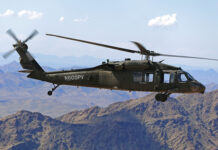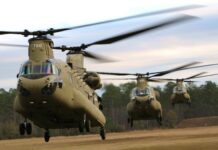The president of Lockheed Martin’s Sikorsky rotorcraft business, Paul Lemmo, provided a considerably upbeat outlook for the company future orderbook in an online briefing to journalists on 1 June 2023, ahead of the Paris Air Show later in the month.
Regarding one of Sikorsky’s signature programmes, Lemmo said the company is confident of securing further Foreign Military Sales (FMS) of its H-60 Black Hawk helicopter to take up the options in its latest multi-year contract for the aircraft. In June 2022 the US Army signed a five-year contract worth around USD 2.3 Bn (EUR 2.14 Bn) for 120 H-60 Black Hawks, with that deal including options for an additional 135 aircraft that are available to the army, other US government agencies and FMS customers. The contract, Sikorsky’s 10th multi-year Black Hawk deal, is thus potentially worth up to USD 4.4 Bn.
“We’re very very much on our way to selling all 255 of those helicopters,” said Lemmo. He noted that Sikorsky has already secured a Black Hawk order this year from Australia, which signed a contract in January for 40 UH-60Ms to replace its troubled fleet of MRH 90 Taipan helicopters, and said that the company continues to see “strong interest around the world in the Black Hawk”.
The UH-60M is also being bid into the UK’s New Medium Helicopter requirement. Although the timeline for this continues to slip, it could ultimately account for the purchase of up to 37 helicopters, the majority of this figure being as replacements for the Royal Air Force’s fleet of 23 Puma HC2s.
The conflict in Ukraine, meanwhile, has drawn attention to the degree to which helicopters can sustain damage and this is likely to show the Black Hawk in a favourable light, Lemmo noted. “What we’re seeing in Ukraine is the need for proven survivable helicopters on the battlefield, and obviously the Black Hawk certainly fits that,” he said. “If you talk to operators around the world, you’ll hear stories, many stories about aircraft being damaged or shot up in battle and flying home safely. That is the hallmark of the Black Hawk. We think it is the most survivable aircraft of its type out there.”
Apart from international sales, however, Lemmo noted that the Black Hawk still has some years to go in US service – including the potential for future sales.
“There was a ‘sources sought’ put out earlier this year for potential Black Hawk production from 2028 through 2033, and obviously we responded to that with interest,” he said. “I don’t know yet you know what the requirements are going to be for that, but we do know that there’s at least some discussions going on and thoughts about with that might look like.
“In addition, to keep the aircraft relevant and also to ensure that it’s compatible with the Future Vertical Lift [FVL] fleet, and can interoperate with it, there will need to be some modernisation of the Black Hawk, and those discussions are also going on,” Lemmo added.
Under the US Army’s FVL initiative the Future Long-Range Assault Aircraft (FLRAA) programme will initially augment, rather than immediately replace, the army’s H-60 fleet. With this in mind Sikorsky is looking at various ways to upgrade the Black Hawk. The aircraft is already slated to receive a new powerplant under the US Army’s Improved Turbine Engine Program (ITEP), and so the company has prepared for that, but Lemmo noted that Sikorsky also intends to implement an open systems architecture in the aircraft and to install a flight control system that would accommodate its Matrix aircraft autonomy technology, which was first demonstrated on a specially modified Black Hawk in October 2022.
Meanwhile, Lemmo acknowledged the importance of the US Army’s Future Attack Reconnaissance Aircraft (FARA) programme to Sikorsky, which he referred to as “very significant; it’s a billion dollar programme for us”.
For the FARA requirement Sikorsky is bidding the Raider X: a compound helicopter with coaxial rotors derived from the S-97 Raider developed by Sikorsky for the US Army’s aborted Armed Aerial Scout programme.
“We are driving towards our competitive prototype getting to first flight next year, once we receive the ITEP engine, which we expect later this year,” said Lemmo. “We will integrate that, begin ground testing and eventually get into flight testing of that aircraft.
“In parallel with the build and test of the competitive prototype,” Lemmo added, “we have a very large ongoing programme with the army to drive towards a preliminary design review and to continue to mature the ultimate design that would go into production, so that continues apace. That is not affected by delays in the ITEP engine; that work continues on as we speak. And that’s going well.
“We continue to fly at a very good op tempo the S-97 Raider,” said Lemmo, describing this as “a very good surrogate for FARA because it’s about 80% of the size of our FARA offering.
“Every day that we fly we can continue to knock down risks on the FARA programme or we’re flying FARA profiles with that aircraft and ensuring that we understand exactly what needs to go into our Increment 1 design for FARA to ensure we offer the best aircraft to the army,” he said.
Although the Sikorsky-Boeing Defiant X design, a larger compound helicopter with coaxial rotors, lost out in the US Army’s FLRAA programme in December 2022 when the army selected the Bell V-280 Valor tiltrotor for the requirement, Lemmo said Sikorsky is working on a smaller design that would have more potential for international sales.
“We did not see Defiant as potentially the right aircraft for a lot of our international partners,” he explained. “It’s very large, and likely to be expensive. It was our view that something a little bit smaller was the right fit, and so we have a concept for an X2 aircraft that fits in between the size of FARA and FLRAA – and that we are maturing.

Sikorsky’s X2 was a high-speed experimental compound helicopter with coaxial rotors that first flew in May 2015. This informed the design of the S-97 Raider that Sikorsky then scaled up into the Raider X for the FARA programme.
“So that is that is what we see as an ideal aircraft for the international market, that meets a lot of the demands that we think would fit well with the European [market] or the NATO Next Generation Rotorcraft Capability [requirement], and potentially Italy’s next-generation fast helicopter,” said Lemmo.
He added that, although this X2-derived design would be smaller than the Defiant X, it would still be a twin-engine design.
Regarding Sikorsky’s other programmes, Lemmo cited the CH-53K King Stallion heavylift helicopter as “probably the largest production programme that we have right now”. He noted that the type was approved for full-rate production last year and that Sikorsky would be “ramping production up to 20 aircraft per year and beyond over the next couple of years”. He added that the company has now delivered the 11th CH-53K to the US Marine Corps (USMC), which currently has 44 such aircraft on order but a requirement for 200. The CH-53K passed its initial operational capability (IOC) milestone in April 2022 and Lemmo noted that the type is currently being prepared for its first deployment.
In terms of international sales, Lemmo noted that seven countries in Asia are looking at requirements that fit the CH-53K and will be running competitions within the next few years, while “three to five countries are in active discussion” with Sikorsky regarding the CH-53K.
“We also continue to see significant interest in the MH-60 Romeo Seahawk,” Lemmo added. He noted that the Spanish Navy will be a future operator of this multi-mission naval helicopter – the Spanish government approved the purchase of eight MH-60Rs in April 2023 – along with Norway, the government of which approved the acquisition of six MH-60Rs in March 2023.
“But beyond that we have a number of other international customers that we are in dialogue with and optimistic that they, too, will be purchasing Romeo helicopters,” said Lemmo.
“We also continue to think about modernisation of that platform as we move forward, both the mission system and the platform itself,” he said, describing this as “one of our top priorities”.
Peter Felstead











